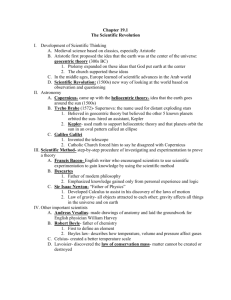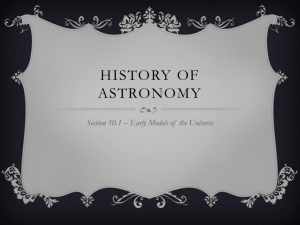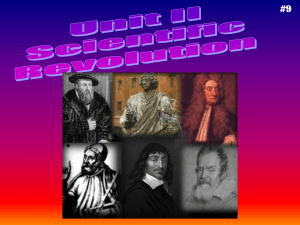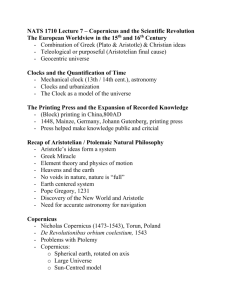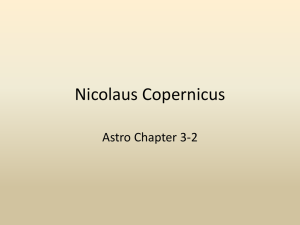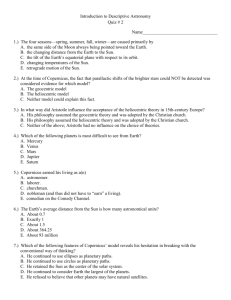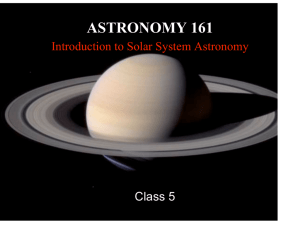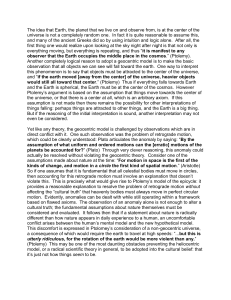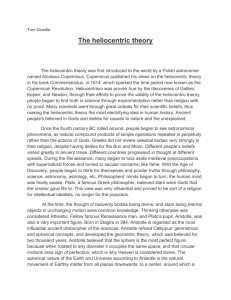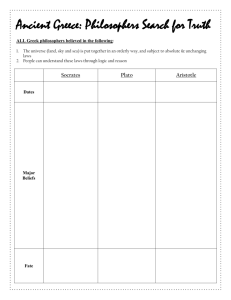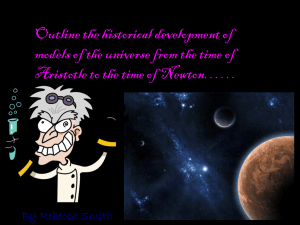Scientific Thinking Before Copernicus
advertisement
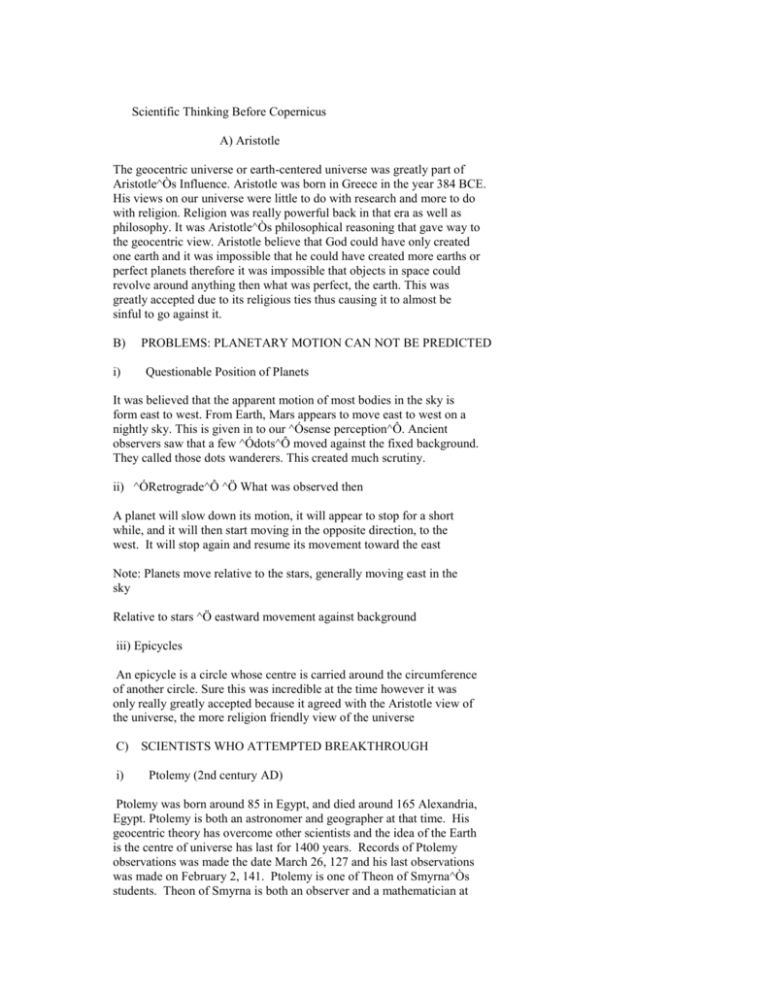
Scientific Thinking Before Copernicus A) Aristotle The geocentric universe or earth-centered universe was greatly part of Aristotle^Òs Influence. Aristotle was born in Greece in the year 384 BCE. His views on our universe were little to do with research and more to do with religion. Religion was really powerful back in that era as well as philosophy. It was Aristotle^Òs philosophical reasoning that gave way to the geocentric view. Aristotle believe that God could have only created one earth and it was impossible that he could have created more earths or perfect planets therefore it was impossible that objects in space could revolve around anything then what was perfect, the earth. This was greatly accepted due to its religious ties thus causing it to almost be sinful to go against it. B) i) PROBLEMS: PLANETARY MOTION CAN NOT BE PREDICTED Questionable Position of Planets It was believed that the apparent motion of most bodies in the sky is form east to west. From Earth, Mars appears to move east to west on a nightly sky. This is given in to our ^Ósense perception^Ô. Ancient observers saw that a few ^Ódots^Ô moved against the fixed background. They called those dots wanderers. This created much scrutiny. ii) ^ÓRetrograde^Ô ^Ö What was observed then A planet will slow down its motion, it will appear to stop for a short while, and it will then start moving in the opposite direction, to the west. It will stop again and resume its movement toward the east Note: Planets move relative to the stars, generally moving east in the sky Relative to stars ^Ö eastward movement against background iii) Epicycles An epicycle is a circle whose centre is carried around the circumference of another circle. Sure this was incredible at the time however it was only really greatly accepted because it agreed with the Aristotle view of the universe, the more religion friendly view of the universe C) i) SCIENTISTS WHO ATTEMPTED BREAKTHROUGH Ptolemy (2nd century AD) Ptolemy was born around 85 in Egypt, and died around 165 Alexandria, Egypt. Ptolemy is both an astronomer and geographer at that time. His geocentric theory has overcome other scientists and the idea of the Earth is the centre of universe has last for 1400 years. Records of Ptolemy observations was made the date March 26, 127 and his last observations was made on February 2, 141. Ptolemy is one of Theon of Smyrna^Òs students. Theon of Smyrna is both an observer and a mathematician at that time. And Ptolemy idea of Earth is the centre of universe is influenced by Aristotle^Òs earth-centered system. This system is based on the Earth is fixed at the centre of universe and the sun, moon, planets and stars orbits the Earth. Ptolemy predicts the positions of the sun, moon and planets using geometric models and epicycles. ii) Aristarchus of Samos (200 BC) He was born in the year 310BC and was a Greek mathematician and astronomer. He wrote On the Sizes and Distances of the Sun and Moon to prove several hypotheses he had on those subjects. He recognized for his development of the theory of the heliocentric universe.Even though there is no doubt that the theory originated with Aristarchus, It is still unsure since the only references lie in allusion in Archimedes^Ò writings, and a reference by Plutarch(Greek Writer) in one of his writings. He proposed the idea of a sun-centered Solar System as early as about 200 B.C. by Aristarchus's of Samos. However, due to the overwhelming weight of Aristotle^Òs influence his theory did not endure long. The difficulty with the Aristotle influence is due to the religious attachment. Main Objections ^Ö · If the Earth actually spun on an axis, why didn't objects fly off the spinning Earth? · If the Earth was in motion around the sun, why didn't it leave behind the birds flying in the air? · If the Earth were actually on an orbit around the sun, why wasn't a parallax effect observed? NOTE: The first two objections were not valid because they represent an inadequate understanding of the physics of motion. The third objection is valid, but failed to account for the enormous distances to the stars, thus causing the amount of parallax to decrease with distance. Copernicus He was born on February 19th, 1473 in Poland. Nicolaus Copernicus through the publication of his heliocentric theory 70 years later became the man who got in the centre of so much controversy. He was born as the son of a merchant, after the death of his father he was raised by a uncle, who allowed him to enter the University of Krakow, which was at that time known for its mathematics, philosophy, and astronomy curriculum. After some time he turned his attention to his loved subject of astronomy. Then it all started; He published the work on the Revolutions of the Heavenly Spheres in 1543. This work challenged the geocentric cosmology that had been accepted since the time of Aristotle. This was considered to be a direct opposition to Aristotle and to the second century astronomer Ptolemy. Copernicus proposed that a rotating Earth revolving with the other planets about a stationary central Sun could account in a simpler way for the same observed phenomena of the daily rotation of the heavens, the annual movement of the Sun through the ecliptic, and the periodic retrograde motion of the planets. Copernicus and his creative thinking The discovery that the universe was heliocentric rather then geocentric was a lateral thinking approach rather then based on the models of Perkins or Miller. Although some ideas do fit in the phases of the two models neither model is fully satisfied. A) Perkin^Òs five-step model Although the invention does not follow this model the paradigm shift does. i. Long search Copernicus grew tired of his life in the church and instead turned his life to one of his other passions, astronomy. Using his knowledge of the cosmos it enabled him to see beyond the geocentric view and come up with other possibilities. ii. Little apparent progress This phase can be seen through the amount of time and resistance that the heliocentric view of the universe went through. iii. Precipitating Event The event that led to the wide spread of this view was the release of Narratio Prima which later led to further research by other scientists. iv. Cognitive Snap There was no cognitive snap. v. Transformation Copernicus^Ò ideas were accepted as a simpler explanation to the phenomena of the daily rotation of the sky, the yearly movement of the sun, and the periodic retrograde motion of the planets. B) Millers thinking process i. Conscience -He viewed the sky daily and took observations. Actively wanted to solve problems ii. Unconscious ^Ö His knowledge and commitment to the problem must have had effect on his unconscious mind iii. Illumination - He realized that he was right and then published his findings. iv. Verification - Even though his ideas were controversial eventually it was accepted because his results were correct. C) Metaphor There was no real use of a metaphor.
